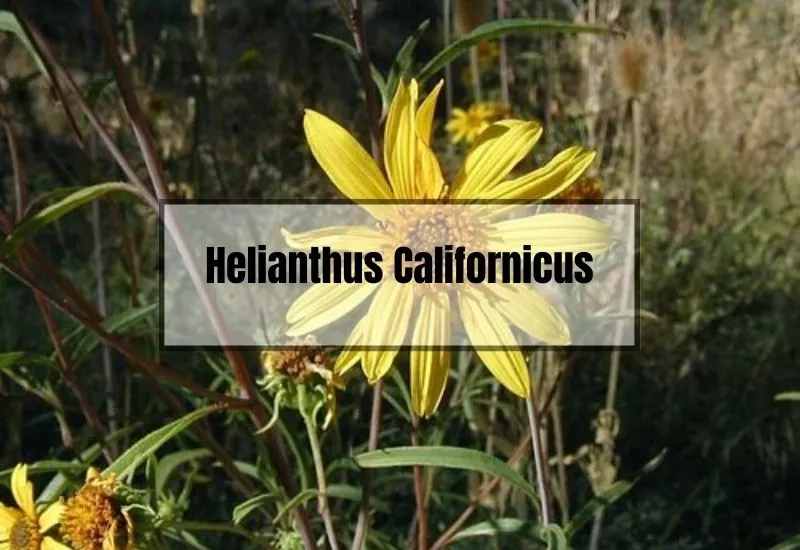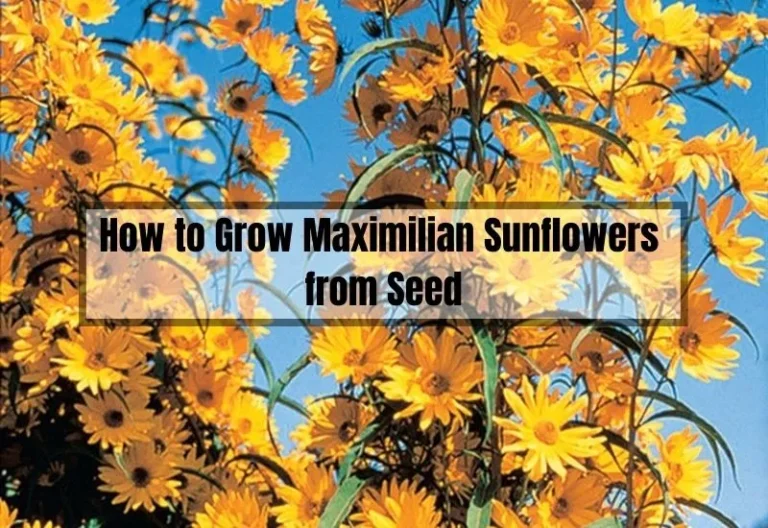Helianthus Californicus Care and Uses: A Guide to This Remarkable Flower
From Louise: Passionate about gardening, I specialize in plant care and flower knowledge. I’m here to share my expertise and assist with your gardening queries. Feel free to ask any questions or seek advice on lawn care—I’ll respond within 24 hours!
Helianthus Californicus, the California Sunflower, is a native perennial known for its yellow blooms and ability to attract pollinators. It’s a hardy plant suitable for novice and experienced gardeners, thriving in various soil conditions.
In this article, we’ll discuss cultivating, care, propagation, pests, diseases, and harvesting Helianthus Californicus.
Key Takeaways
- Helianthus Californicus is a hardy perennial plant that is native to California and Baja California and is known for its stunning yellow blooms and ability to attract pollinators.
- Cultivating and caring for Helianthus Californicus is relatively easy and the plant can thrive in a variety of soil types and conditions.
- The most effective propagation methods, common pests and diseases, and how to harvest and store Helianthus Californicus will also be discussed in this article.

What is Helianthus Californicus?
Helianthus Californicus, or the California sunflower, is a gem hailing from the sunflower family. With its origin rooted firmly in the Western part of North America, this sunflower carries an innate spirit of wild adventure and untamed beauty.
Much like a determined wanderer braving the unknown, the Helianthus Californicus has carved out its niche in a diverse range of environments, from open woodland to grassy slopes and coastal areas.
Its botanical details are equally as fascinating. Sturdy roots anchor the plant into the earth, leading up to tall, slender stems that can reach up to 8 feet in height. Broad, lance-shaped leaves adorn these stems, providing a lush, green backdrop for the main attraction: its flowers.
Oh, and what flowers they are! Large and vibrant, they boast a bright yellow disk with a surrounding halo of golden-orange rays. As autumn rolls in, the plant bears achenes, small, hard fruits each containing a single seed.
Uses of Helianthus Californicus
This sunflower isn’t just a pretty face. With its vivid bloom and diverse uses, the Helianthus Californicus is like the multitasking friend who excels at everything they try.
Ornamental Uses
The Helianthus Californicus is quite the showstopper in gardens, with its towering height and golden blossoms providing an irresistible focal point.
Whether they’re adorning borders or flower beds, or standing tall in a vase as cut flowers, they’re sure to bring a burst of sunny cheer to any setting.
Ecological Uses
Environmentally speaking, Helianthus Californicus is a bit of a superhero. Its large, nectar-rich flowers are a favorite among bees, butterflies, and other pollinators. In its native habitat, it forms a key part of plant communities, contributing to a balanced and vibrant ecosystem.
Additionally, its sturdy root system helps prevent soil erosion, thereby playing a crucial role in maintaining the integrity of the landscape.
Medicinal Uses
Traditional medicine also recognizes the merits of this sunflower. Folk remedies have long utilized the plant, and while I’m not one to consume random plant matter, modern science has also taken an interest in studying its potential medicinal properties.
How to Care for Helianthus Californicus
If you’re looking for a plant that is easy to grow and care for, Helianthus Californicus is a great choice.
This plant is native to California and Baja California, and it’s known for its bright yellow flowers that bloom from late spring to early fall. Here are some tips on how to cultivate and care for Helianthus Californicus:
Optimal Growing Conditions
Helianthus Californicus, true to its name, loves a good dose of sunshine. Plant it in a spot where it will receive at least six hours of sunlight a day.
In terms of soil, it’s pretty easy-going and can tolerate a range of conditions, though well-draining soil is preferred to prevent waterlogging.
Watering
When it comes to watering, Helianthus Californicus doesn’t need much. It’s a drought-tolerant plant that can survive on very little water, so be careful not to overwater it.
Water it once a week during the growing season, and reduce watering during the winter months.
Fertilization
Helianthus Californicus doesn’t require much fertilization. You can give it a small amount of balanced fertilizer in the spring to encourage growth, but avoid fertilizing it during the fall and winter months.
Pruning
Helianthus Californicus doesn’t require much pruning, but you can trim it back in the fall after it has finished flowering.
This will help keep the plant looking neat and tidy, and it will also encourage new growth in the spring.
Pests and Diseases
Helianthus Californicus is generally a healthy and disease-resistant plant. However, it can be susceptible to aphids and spider mites. If you notice any pests on your plant, you can spray it with a mixture of water and dish soap to help get rid of them.
Overall, Helianthus Californicus is an easy plant to grow and care for. With a little bit of attention and care, you can enjoy its beautiful yellow flowers for many years to come.
Propagation of Helianthus Californicus
If you want to propagate Helianthus Californicus, you can do so using seeds or cuttings. Here are some methods you can use:
Seeds
Seeds are the easiest way to propagate Helianthus Californicus. You can collect seeds from the plant in the fall and sow them in the spring. Here are the steps you can follow:
- Collect the seeds from the plant in the fall.
- Store the seeds in a cool, dry place until the spring.
- Sow the seeds in well-draining soil in the spring.
- Keep the soil moist until the seeds germinate.
Cuttings
You can also propagate Helianthus Californicus using cuttings. Here are the steps you can follow:
- Take a cutting from the plant in the spring or summer.
- Dip the cutting in rooting hormone.
- Plant the cutting in well-draining soil.
- Keep the soil moist until the cutting roots.
Propagation of Helianthus Californicus is relatively easy, and you can use either seeds or cuttings. Just make sure to follow the steps above and provide the plant with the right growing conditions.
Helianthus Californicus in Different Seasons
Watching a Helianthus Californicus navigate different seasons is akin to observing an old friend adapt to new situations. It’s a dynamic process, filled with moments of growth, rest, and rejuvenation.
As the seasons change, so does the plant. It slows down in winter, conserving its resources, and bursts into activity in the spring and summer. Caring for the plant also shifts with the seasons, as it requires more protection in colder months and more water during dry periods.
What are the Common Pests and Diseases?
Helianthus Californicus is a hardy plant that can withstand a variety of conditions. However, it is still susceptible to pests and diseases that can damage or kill the plant.
In this section, we will discuss some of the most common pests and diseases that affect Helianthus Californicus.
Pests
- Aphids: These are small, soft-bodied insects that feed on the sap of the plant. They can cause the leaves to curl and yellow, and can also transmit viruses to the plant.
- Seed Weevils: Gray and red seed weevils are the most common pests that damage Helianthus Californicus. The adults feed on pollen and lay eggs in developing seeds, which the larvae eat once hatched. This can cause the seeds to become hollow and not develop properly.
- Caterpillars: There are several species of caterpillars that can feed on the foliage of Helianthus Californicus. Corn earworm, obliquebanded leafroller, painted beauty, and sunflower moth are some of the most common. These pests can cause damage to the leaves, stems, and flowers of the plant.
Diseases
- Powdery Mildew: This is a fungal disease that can affect the leaves, stems, and flowers of Helianthus Californicus. It appears as a white or gray powder on the plant and can cause the leaves to curl and yellow.
- Root Rot: This is a disease caused by fungi that can affect the roots of the plant. It can cause the plant to wilt and eventually die. Overwatering and poor drainage can contribute to the development of root rot.
- Rust: This is a fungal disease that can affect the leaves and stems of Helianthus Californicus. It appears as small, orange or brown spots on the leaves and can cause the leaves to yellow and fall off.
To prevent pests and diseases from affecting your Helianthus Californicus, it is important to keep the plant healthy and well-maintained.
Regularly inspect the plant for signs of pests or diseases and take action immediately if any are found. Proper watering, fertilization, and pruning can also help keep the plant healthy and prevent the development of pests and diseases.
How to Harvest and Store?
Harvesting Helianthus Californicus is a relatively simple process. The best time to harvest the plant is when the flowers have started to wilt and the seeds have begun to dry out. You can tell if the seeds are ready for harvesting by gently rubbing the seed head with your fingers. If the seeds fall out easily, then they are ready to be harvested.
To harvest the seeds, cut the entire seed head off the plant using a pair of sharp scissors or pruning shears. Be sure to cut the seed head off at the base of the stem. Once you have harvested the seed head, you can remove the seeds by rubbing them gently with your fingers or by using a fork to comb them out.
After you have harvested the seeds, it is important to store them properly to ensure that they remain viable. The best way to store Helianthus Californicus seeds is in a cool, dry place. You can store them in an airtight container, such as a glass jar or a plastic bag, and place them in the refrigerator or freezer.
If you plan on storing the seeds for an extended period of time, you may want to consider treating them with a fungicide to prevent them from developing mold or other fungal infections. You can also store the seeds in a paper bag or envelope, but be sure to label the bag or envelope with the name of the plant and the date of harvest to keep track of them.
Frequently Asked Questions (FAQs)
Is Helianthus Californicus invasive?
No, Helianthus Californicus is not considered invasive.
Can Helianthus Californicus grow in containers?
Yes, Helianthus Californicus can grow in containers, but choose a large container with adequate drainage and support for the tall plant.
How do you propagate Helianthus Californicus?
Helianthus Californicus can be propagated by seed or by dividing established plants in the fall.
What pests and diseases affect Helianthus Californicus?
Helianthus Californicus is generally not affected by pests or diseases, but it can be susceptible to powdery mildew in humid conditions.
Can Helianthus Californicus tolerate frost?
No, Helianthus Californicus is not frost-tolerant and should be protected from frost in colder climates.
Conclusion
Helianthus Californicus is a beautiful and versatile plant that can add a bright and striking pop of color to any garden or landscape. Its golden yellow flowers not only add beauty but also serve as a food source for essential pollinators. It is easy to care for and can be grown in various conditions, making it a great
Related Posts:





